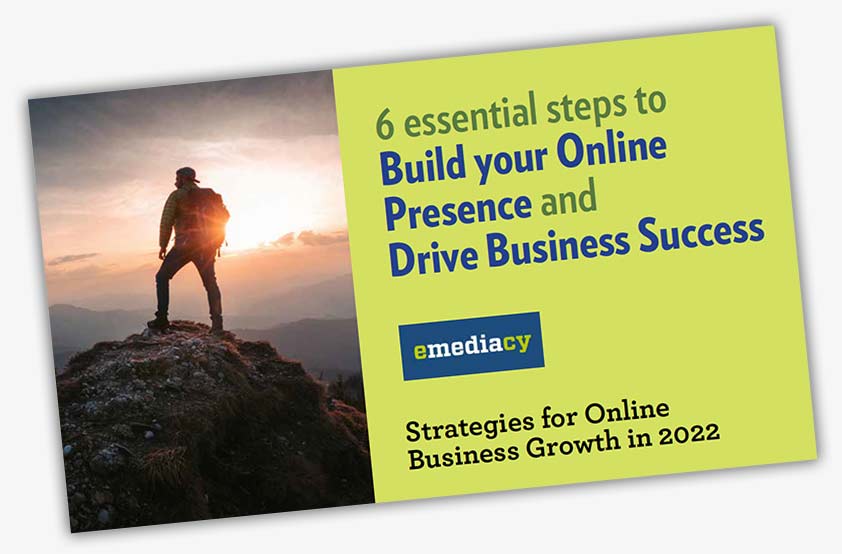Step 1: Choose your off-page SEO techniques and tactics
What off-page SEO techniques and tactics should I choose for my marketing plan?
For successful off-page SEO, it is important to implement the right techniques and tactics. Here is a list of the top off-page SEO tactics that can help you get top Google rankings in 2023:
Evaluate and improve your backlink profile: Use tools like Google Search Console, Ahrefs, Moz or SEMrush to analyse your backlink profile and identify opportunities for improvement.
Analyse your competitors backlink profiles: Get insight into the strength of your backlink profile by researching your competitors backlink profiles.
‘Utilize social media: Use social media platforms to build relationships, link to your content and drive traffic to your website.
Leverage content marketing: Publish content that is valuable to your target audience and let them share it to improve your rankings.
Participate in online communities: Engage in forums and other online communities to build relationships with potential customers and improve your brand visibility.
Set up influencer campaigns: Identify influencers in your industry and collaborate with them to reach a wider audience.
Implement guest blogging: Reach out to potential guest bloggers and write quality content for their blog to get backlinks.
Utilize press releases: Write press releases about your business, products, or services and share it with the media to create more awareness.
Participate in link roundups: Find link roundups in your industry, give recommendations and get backlinks.
Make use of local SEO: Aim to appear in local search results by optimizing your content for local keywords and creating local citation sites.
By utilizing these off-page SEO techniques and tactics, you can significantly enhance the position of your website in SERPs and drive more qualified traffic to your site.
Experience the power of website design and Content Marketing SEO services – contact Emediacy today!
Step 2: Work on creating shareable content
Creating shareable content can be a powerful tool to help with off-page SEO. When content is created with an aim to engage a wide audience, it can lead to increased exposure and increased traffic to a website or blog. Additionally, when people find content that is interesting or informative, they are more likely to share it with others, which can further help increase the visibility of the content and drive more backlinks to the site. With the help of social media influencers, content can be shared even more widely, leading to even more backlinks and higher SEO rankings. Finally, using social media scheduling apps like Planable or Hootsuite can help to save time in managing and promoting content on various social media channels.
Step 3: Diversify your backlinks
Diversifying your backlinks can help with off-page SEO by giving your site the best chance to rank for a variety of keywords and by giving you the opportunity to experiment with different tactics. This can include writing guest posts for popular blogs, targeting PR efforts at Tier 1 publications, submitting products to review sites, and getting links from local businesses. Having a variety of backlinks from a variety of sources can help increase the overall authority of your website and make it more attractive to potential customers. Additionally, by diversifying your backlinks, you can also ensure that your site is not overly reliant on any single source for its backlinks, as one source could disappear and leave your site vulnerable. Having a diverse backlink profile is an essential part of any off-page SEO strategy.
Step 4: Create amazing content
Having amazing content can significantly improve your off-page SEO. Content that is interesting, informative, and entertaining, and appeals to a wide audience, will be more likely to be shared and create natural backlinks to your website or blog. Quality backlinks to your website will improve your website’s overall authority, making it easier for you to rank your pages in the future. To create incredible content that people can’t help but share, you should research often and keep your content up to date. Additionally, you should create content that is authentic to your brand and resonates with your audience. Informational content is the best way to create quality backlinks, as opposed to promotional pages, such as product and service pages. With the right content, you can craft an effective off-page SEO strategy.
Step 5: Take a look at your backlink profile
Taking a look at your backlink profile can help with off-page SEO by allowing you to evaluate which sites link back to your own, the amount of times they link, and which pages are receiving the most clicks. With tools like Google Search Console, Ahrefs Backlink Checker, and Screaming Frog, you can check your domain authority or domain rating for an overall backlink profile score, and analyze your competitors’ backlink profiles for comparison. Additionally, by improving your internal linking, you can set your off-page SEO strategy up for success.
Step 6: Reach out to influencers
Reaching out to influencers can be an important part of implementing off-page SEO techniques and tactics into a marketing plan. Influencers have the power to make an impression on users, and the larger their following on social media, the more impact they can have. By having influencers leave reviews about products, adding product placement in their content, or making brand mentions and product recommendations, brands can increase their brand authority. Additionally, brands can ask influencers to share their content, and linkbacks from their blog can be beneficial for SEO. Furthermore, interacting with industry figures on platforms such as Twitter and in comment sections can help to build relationships, attract new audiences, and amplify content. All of these tactics are essential for building a successful marketing plan.
Step 7: Incorporate infographics into your site
Using infographics on your website can help with off-page SEO in a number of ways. By creating interesting and compelling infographics and submitting them to infographic submission platforms, you can create backlinks to your website or blog. This can help to improve your search engine rankings as it will increase the number of links pointing back to your website. Additionally, publishing infographics on social media can further increase the potential reach of your content, helping to attract more visitors to your website. Optimizing your infographic for search engines by including relevant keywords in the title, description, and file name will also help to improve your SEO performance. Lastly, tracking and analyzing the performance of your infographic can provide valuable insights into how it is impacting SEO and help inform future strategies.
Step 8: Participate in online directories
Participating in online directories and listings can help with off-page SEO in several ways. Firstly, these directories and listings provide backlinks to your website, which can help improve your website’s visibility and authority in search engine results pages. Secondly, submitting your website to online directories and listings can help you reach a larger audience and increase your exposure. Thirdly, when submitting your website to directories and listings, it’s important to ensure that the information you provide is accurate, consistent, and up-to-date, including relevant keywords in your listings titles and descriptions. Finally, participating in search forums about your website and business and building relationships with the community can help you boost your off-page SEO.
Step 9: Use online directories submission tools
Directory submission tools can help with off-page SEO by providing backlinks to a website, improving visibility and authority in search engine results pages, and helping reach a larger audience. When submitting to online directories and listings, it’s important to ensure that the information provided is accurate, consistent, and up-to-date. Additionally, including relevant keywords in the listing title and description can help improve the effectiveness of the submission. Additionally, listing the website in directories and forums that are specific to the industry or niche can be beneficial. Submitting articles, videos, and images to high-DA websites can help build quality backlinks and gain greater exposure. By submitting to these sites, businesses can improve their visibility and authority, increasing their chances of appearing higher in search engine results pages.
Step 10: Collaborate on creative projects with agencies or specialists
Off-page SEO is a powerful tool for boosting search engine rankings, and it can be used to collaborate on creative projects with agencies or specialists. Here is a step-by-step guide to getting the most out of off-page SEO:
Start by customizing your profile. Look for relevant topics to your industry and start following them. This will help you build relationships with industry figures and gain insight into trends and topics.
Take advantage of social media platforms. Twitter, LinkedIn, Facebook, Instagram, and TikTok provide excellent opportunities to engage with your audience and build your off-page SEO. Use these platforms to share valuable content and create a great user experience.
Reach out to influential figures. Connect with figures in your industry and look for ways to engage with them. Doing so will increase your chances of gaining exposure and boosting your off-page SEO.
Create and share infographics. Infographics are becoming increasingly popular on the internet. Create your own infographics and submit them to infographics submission websites with links to your webpage or blog.
By following these steps, you can optimize your off-page SEO and collaborate with agencies and specialists to achieve your desired results.
Step 11: Take advantage of video marketing platforms
Video marketing platforms can be used for off-page SEO by following these steps:
Maximize Creating Video Content: Create high-quality videos that are relevant to your website or business. Make sure to include a clear description, reference links, tags, and a catchy title. This will allow your content to be more easily discovered by search engines and users.
Social Networking Sites: Join popular social networks to promote your video content. Post links to your videos on Twitter, Facebook, Google+, and other channels to increase your online presence and grow your network of contacts.
Search Engine Submission: Submit your videos to major search engines such as Google, Yahoo, and Bing. This will help your videos show up faster in search results.
Directory Submission: Submit your videos to specialized directories related to your industry. This will help increase the visibility of your videos and draw in more targeted traffic.
Social Bookmarking: Share your videos on social bookmarking sites like StumbleUpon, Digg, Delicious, and Reddit. This will help your content get indexed faster and improve your search engine rankings.
Link Baiting: Create interesting, eye-catching videos that are likely to be shared by others. This will help increase your link popularity and draw in more visitors to your website.
Photo/Video Making & Sharing: Utilize photo and video sharing sites such as Flickr and YouTube to share your videos with a wider audience. This will help extend the reach of your videos and help improve your SEO efforts.
Step 12: Submit your images properly
Bonus Step 13 : Talk it up on social media
Social media plays an important role in effectively implementing off-page SEO techniques into a marketing plan. One way to do this is by creating valuable content and providing a great user experience, which will encourage users to link back to the content. Additionally, companies can assign a staff member to actively engage with their audience on various platforms, such as Twitter, LinkedIn, Facebook, Instagram, and TikTok. This will help to build their brand and off-page SEO.
Infographics and file-sharing websites are also useful for link building. Companies can create visually appealing infographics and submit them to platforms that specialize in infographic submission. They can also create documents in pdf or ppt formats and submit them to file-sharing websites.
Finally, companies can build relationships with industry figures on social media, which will reflect positively on their website. This may even result in those figures sharing the company’s content with their followers. Engaging with these people in the comment sections of their websites is also beneficial and will increase the chances of developing a personal relationship with influencers.
Overall, social media is an effective way to implement off-page SEO techniques and tactics into a marketing plan, as it can help to build relationships, share content, and generate quality backlinks.
Other Content Ideas
- Promoted Article
- Promotional Content Sharing
- Content Marketing Content Syndication
- Viral Content Viral Marketing
- Social Media Engagement
- Video Submission
- Press Release
- Question and Answer
- Customer reviews
- Infographics Submission
Attract more customers with Emediacy Oregon website design and Content Marketing SEO services – start now!
FAQ
What is off-page SEO?
Off-page SEO is the process of optimizing a website or blog’s external factors to influence its ranking on search engine results pages (SERPs). It involves activities that take place outside of the website such as link building, guest posting, social media marketing, and more. The goal of off-page SEO is to build trust and credibility, increase relevance, and earn higher rankings in SERPs. It is an essential part of a successful SEO strategy, as it helps to create a more authoritative and trustworthy website. Off-page SEO involves activities such as creating backlinks and brand mentions, content marketing, and engaging with followers on social media. These activities help to improve visibility, authority, and credibility, and can be the deciding factor when multiple sites use similar on-page strategies.
What are some off-page SEO techniques and tactics?
What are some off-page SEO techniques and tactics? [Expanded list]
Off-page SEO tactics are essential to improving the ranking of websites in Search Engine Results Pages (SERPs). These tactics involve activities outside of the website itself and can include link building, content marketing, local SEO, guest blogging, reviews, and events.
Link building involves creating backlinks on other websites to increase the credibility of a website. Content marketing involves creating content that engages users and promotes the website. Local SEO (GMB and Citations) involves optimizing a website for local search engine results, such as businesses showing up in the local map pack results. Reviews involve obtaining reviews from users to increase trust with search engines. Finally, events involve attending and hosting events such as webinars and conferences to promote the website.
In addition to these, other off-page SEO techniques and tactics include creating shareable content, influencer outreach, contributing as a guest author, broken link building, converting brand mentions, strong internal linking, social media engagement, social bookmarking sites, forum submission, blog directory submission, article submission, question and answer sessions, video submission, image submission, infographic submission, document sharing, press release submission, and using Google My Business. Each of these off-page strategies can help to improve the ranking of a website in SERPs, and when used together, they can have a significant impact on website visibility.
How do I create backlinks for my website?
Creating quality backlinks for your website can be a difficult process, but it is a key element of any successful SEO strategy. Here are some steps you can take to build effective backlinks:
Build connections with other businesses in your niche and reach out to different webmasters for backlinks to your website.
Create hyperlinks from reputable directory websites as an additional traffic source.
Produce compelling visual content such as infographics and videos, and add a link for the source of that content. You can also provide an Embed code so that people can easily share the content with a link back to your website.
Guest posts relevant content on other blogs.
Perform a link gap analysis to identify sites that link to your competitors but not your content. Then, attempt to connect with these websites or research the type of posts they favor to produce similar articles.
Research other content that has attracted a lot of backlinks, such as list posts, quizzes, videos, infographics, and how-to articles.
Make sure to follow the Google Webmaster Guidelines when building backlinks.
By following these steps, you can secure valuable backlinks from reputable sources and create an effective link building strategy for your website.
How important is keyword research for off-page SEO?
Keyword research is an essential factor in both on-page and off-page SEO. For on-page SEO, proper keyword targeting allows you to attract the relevant links that will help boost your search engine rankings.
For off-page SEO, keyword research is also crucial. As link relevancy is a major factor in ranking, it is important to target the right keywords. You must pick keywords related to your niche and use them around your content when writing.
Additionally, use your primary keywords in the title tag and LSI keywords in your content to improve search performance for a specific keyword. You can use tools such as LSIgraph.com to find the relevant LSI keywords for your niche topic. Furthermore, focus on long-tail keywords to increase organic traffic.
After optimizing your content with the relevant keywords, it is essential to focus on gaining quality backlinks. This will help boost your search engine rankings as well.
All in all, keyword research is an important factor in both on-page and off-page SEO. It is essential to target the right keywords in order to optimize your content for search engines and attract the right links.
How do I optimize my website for search engine rankings?
If you want to improve your website’s search engine rankings, there are several steps you can take. Firstly, make sure your website is optimized for mobile devices. Sites that are not optimized for mobile are likely to rank lower in Google’s search results than those that are mobile-friendly. You can use responsive design, which automatically adjusts the layout of your site to fit the screen size of the device being used, or create a separate mobile page version of your website specifically designed for smaller screens.
Secondly, improve website speed and performance, as well as the user experience for mobile visitors. This can include anything from image optimization to compressing code, caching files, and reducing redirects.
Thirdly, create high-quality content that is easy to read and appeals to your audience. This could include keyword optimization and addressing the specific search intent of your target audience.
Fourthly, optimize for local search queries if you have a brick-and-mortar business or serve a specific geographic area. This can be done by claiming and optimizing your Google My Business listing and by including your location on your website.
Finally, leverage off-page SEO techniques such as link building, social media promotion, and content marketing to boost your rankings.
By following these steps, you can optimize your website for search engine rankings and ensure that your site is seen by the right people.
How do I get my website to rank higher in search results?
Getting your website to rank higher in search results requires a combination of both on-page and off-page SEO tactics. Here is a step-by-step guide to help you boost your website’s rank:
On-Page SEO:
Optimize your content by including targeted keywords throughout.
Create meta tags for your website, including a title tag, description tag, and image tag.
Make sure your website is mobile-friendly and optimized for speed.
Off-Page SEO:
Build high-quality backlinks. This can be done by writing guest posts on external sites, commenting on other blogs, and participating in social media.
Join high PR question-and-answer sites, and provide accurate answers to questions related to your business, blog, or website.
Submit your website to the most popular search engines such as Google, Yahoo, and Bing.
Submit your website to niche directories and pick the appropriate category for promotion.
Reach out to influencers in your industry and ask them to promote your website.
By following these steps, you can significantly improve your website’s ranking and visibility in search engine results.
What is the difference between on-page and off-page SEO?
The difference between on-page and off-page SEO is that on-page SEO focuses on optimizing the website itself, such as content, title tags, keyword usage, and internal links. Off-page SEO, on the other hand, involves activities outside the website such as social media, content marketing, and link building. On-page SEO is more of a show-stopper, as it is all about optimizing the website to rank higher on search engine results pages. Off-page SEO is more like the “behind the scenes” of SEO, as it helps to complement on-page SEO strategies and improve overall visibility on the internet. On-page SEO is easier to control, as it is all about the website itself, but off-page SEO takes longer to build up since it relies on other websites, platforms, and applications. Both on-page and off-page SEO are necessary to build a strong link building strategy and develop a website’s presence in search engines.
How do I measure the effectiveness of my off-page SEO efforts?
Measuring the effectiveness of your off-page SEO efforts is essential if you want to get the most out of your efforts. Here is a step-by-step guide to do just that:
Step 1: Use tracking tools to monitor your progress. Google Analytics can give you data on your website’s traffic and referral sources while Ahrefs and SEMrush can help you monitor your backlink profile and track your website’s visibility in search engine results pages.
Step 2: Track your backlinks. Keep track of the number and quality of the backlinks your website is getting.
Step 3: Monitor your website visibility. Find out how well your website is ranking in search engine results pages.
Step 4: Check your competitors. Monitoring your competitors can give you an overview of what is working in your industry.
Step 5: Use a benchmarking tool. Get a quick snapshot of your off-page SEO status by using a tool like WebFX’s SEO checker .
Step 6: Make necessary adjustments. Once you have measured your progress, you can identify areas where you need to make improvements and adjust your strategy accordingly.
By following these steps, you can measure the effectiveness of your off-page SEO efforts and ensure that you are getting the most out of your efforts.
What tools should I use to optimize my off-page SEO?
What tools should I use to optimize my off-page SEO? [Expanded list]: When it comes to off-page SEO optimization, there are several tools available to help you create a strong strategy and stay updated on Google algorithms. These tools include free and paid options such as Google Search Console, Ahrefs, Moz, Screaming Frog, SEMrush, and Moz Link Explorer. Using these tools, you can evaluate your backlink profile and check the backlink profiles of your competitors. Additionally, you can improve your internal linking with Screaming Frog, which helps you identify which pages need links and allows you to optimize your anchor text. With these effective off-page SEO optimization tools, you can ensure your website is seen and indexed by search engines.
How do I ensure my off-page SEO efforts are successful?
If you want to make sure that your off-page SEO efforts are successful, there are certain steps you need to take. First, you need to secure valuable backlinks. This can be done by submitting your website to online directories and listings, participating in social media marketing, and engaging in influencer marketing. Next, be more active on social media, post on forums, consider investing in local SEO, add an RSS feed subscription box, and share your documents. Additionally, guest post on third-party websites, spend more time in comment sections, and build relationships with influencers and industry figures. Finally, monitor your progress and adjust your strategy as needed. With patience, persistence, and a well-rounded strategy, you will be able to master off-page SEO and boost your website’s visibility and credibility in search engine results pages.














